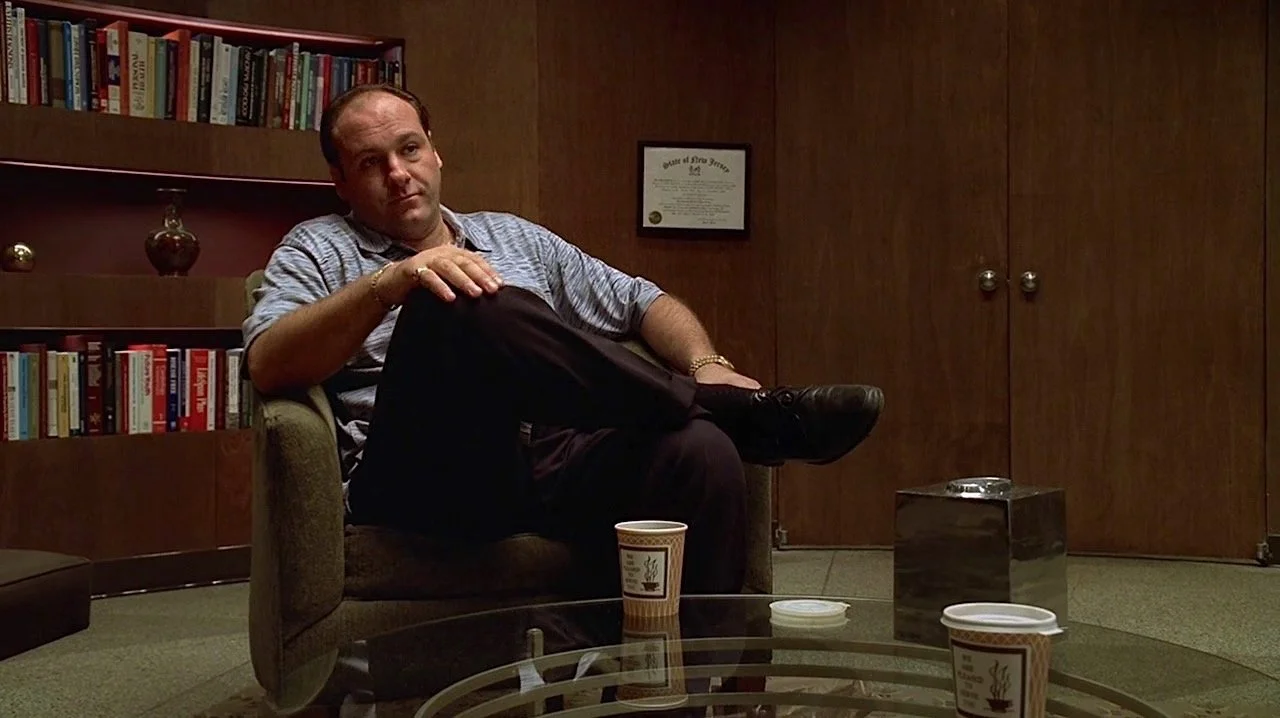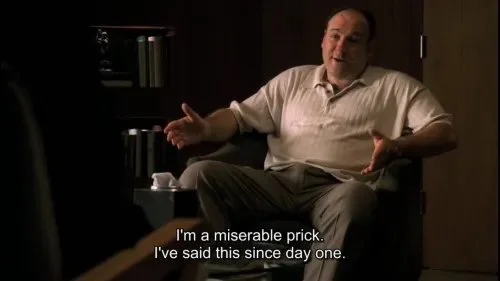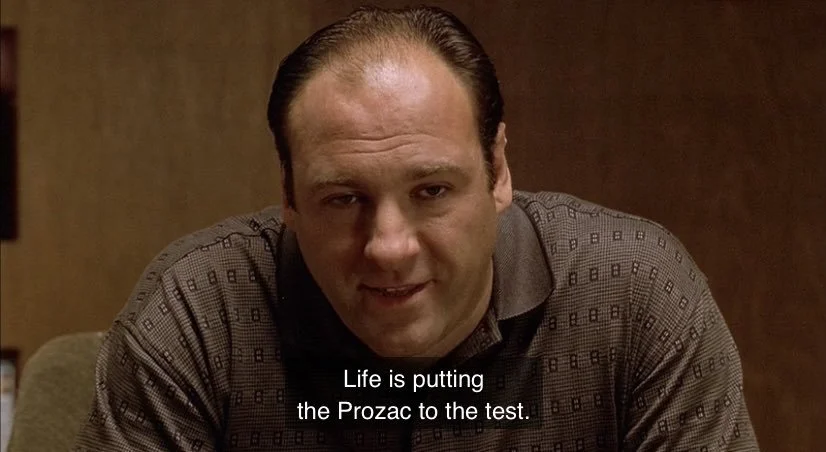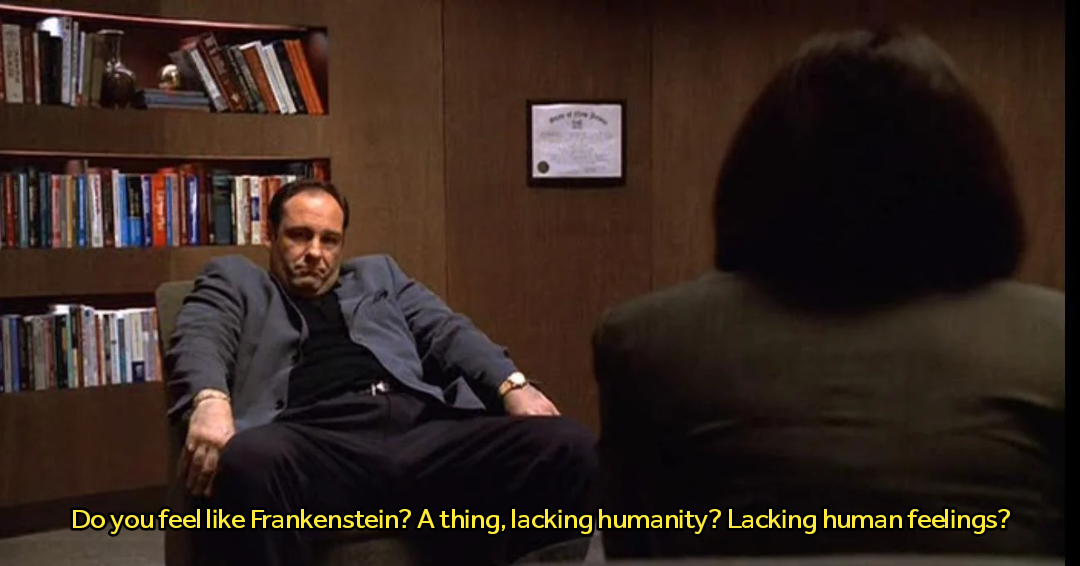Tony Soprano Walked So the Therapy Generation Could Run: A Retrospective
By Francesca Rompal, MA
Photo: HBO
Britney Spears’ “Toxic” is playing on the radio. Logomania it-bags and frosted eyeshadow are in, Lindsay Lohan is on every tabloid cover. Your Motorola Razr flips open with a satisfying snap. It’s the early 2000s, and therapy is still for ‘crazy people.’
Back then, nobody said “anxious.” You were dramatic. Moody, high-strung. Depression was either whispered about behind closed doors or joked about in passing as an excuse for bad behavior. For men—particularly men—the only acceptable form of vulnerability was a midlife crisis, aggression, alcohol, or affairs. Feelings were for women. Maybe for artists. Certainly not for dads.
And then The Sopranos aired. And with it, the beginning of a slow cultural shift.
Tony Soprano—mob boss of North Jersey, father, husband, killer—walked into a psychiatrist’s office and changed television forever. Here was a man who could strangle someone with his bare hands, then drive straight to a quiet office building to talk about his mother. James Gandolfini’s portrayal was iconic not just because Tony was terrifying, but because he was, unsettlingly, familiar. We all knew a Tony. Some of us were raised by him. Some of us married him. Some of us are still unlearning him.
Tony is introduced not as a brute, but as a man who collapses under the weight of it all—literally. His first panic attack in the pilot isn’t caused by a rival family or a shootout at the Bing. It’s a flock of ducks. The threat of loss. The fear of change. That kind of poetic symbolism became The Sopranos’ specialty—showing us how even the most hardened exteriors are usually held together with threadbare coping mechanisms and repressed grief.
During Y2K, male vulnerability looked like a joke. In today’s language, Tony is “emotionally avoidant,” “deep in a trauma response,” “stuck in a pattern of generational wounding.” Back then? He was just a guy with “issues.” The show never tried to fix him, and that was the point.
The Mob Boss and the Meat Locker
Tony’s masculinity is often built like a meat locker: cold, rigid, and full of unspoken rot. His entire world is built on dominance, intimidation, and the performance of power. In many ways, Tony’s therapy sessions are a masterclass in Symbolic Interactionism—where life's a stage and we are all just performing the roles we think we’re supposed to play. And yet, his real unraveling happens when those roles start to crack. Husband. Patriarch. Provider. Mobster. Each of them comes with rules he didn’t write but must follow anyway.
In one scene, Tony admits:
“I find I have to be the sad clown: laughing on the outside, crying on the inside.”
That single line—melodramatic, maybe, but honest—encapsulates an entire generation of men who were told to “man up” while slowly breaking inside. He wants help. But he also wants to be feared. He wants to be understood, but never challenged. He wants his kids to be safe—but keeps harming them anyway.
Tony is constantly searching for absolution in a world that refuses to give it. He speaks in contradictions—he’s self-aware but unwilling to change. Violent but sentimental, both protective and abusive. Capable of reflection, but only to a point.
“Obviously, I’m prone to depression… a certain bleak attitude about the world,” he shares. “But I know I can handle it.”
He says this with almost no irony—right after describing the overwhelming guilt he feels about passing on his pain to his children. There’s something so distinctly masculine about that statement. A generation taught that emotional pain is just a thing you carry. Quietly, stoically, in a walk-in freezer inside your chest. You “handle it.”
But Tony can’t handle it. He spirals. He drinks. He cheats and dissociates. He self-destructs in the most stereotypical ways men are taught to: with addiction, violence, avoidance, transactional sex, and distance from the people who love him most. In the language of healing, he’s repeating the trauma cycle. In mob speak, he’s just doing business.
Photo: HBO
It’s Tony’s inability to “handle it” that made him revolutionary. Because The Sopranos arrived in a cultural moment desperate for an antihero, it gave us one who felt as broken and confused as the people watching him. Long before therapy-speak was memeable and long before ‘mental health’ became a corporate buzzword, Tony was trying to make sense of his own unraveling, fumbling toward self-awareness while actively destroying himself at the same time.
It’s the contradictions that make this character so intriguing. Tony isn’t aspirational; he’s recognizable. He’s the dad who never says “I love you” without adding a punchline. The boyfriend who texts “wyd” instead of “I miss you.” The man who apologizes with a gift instead of accountability. We don’t root for him because he’s good—we root for him because we see him everywhere.
Including in ourselves.
The Modern Man’s Wound
In a now-famous session, Tony tells Dr. Melfi:
“Your kids though… It’s like when they’re little, and they get sick… you’d give anything in the world to trade places with them… so they don’t have to suffer. And then to think you’re the cause of it."
That line is brutal because it’s clear: he knows what he’s done. This is not a man in denial. This is a man drowning in the awareness of how much pain he’s caused—and continuing to cause it anyway. There’s no growth arc. Just loops. Trauma doesn’t always resolve neatly. Sometimes, it just calcifies.
In many ways, Tony is the prototype of the therapy-resistant man: self-aware, but unmoved. He wants help, but doesn’t want to change. He acknowledges his trauma, then punishes others for it. He hates himself, and makes sure you hate him too. And that, in many ways, is modern masculinity—especially for men raised in pre-therapy eras.
Photo: HBO
Throughout The Sopranos, we watch Tony spiral into everything society taught him to reach for—booze, women, power, food, money. What looks like indulgence is actually a man trying to disappear. And that hasn’t changed. Only now, the extremes are more polished. We’ve split the masculine psyche into archetypes again—when maybe what we needed was just one character who embodied the middle.
We’ve dressed up the masculine meltdown in better fonts. But the core wound is still the same: men who were never taught how to sit with pain without transferring it. And the ones who suffer are usually the ones closest to them.
Alpha Males and Incels Are the Same Guy in Different Sunglasses
We’re stuck in a binary hellscape of masculinity. On one end, the "alpha male" grifter with a six-pack, a ring light, and a Red Bull addiction (at best). On the other, the chronically online incel blaming women for everything that has ever happened since the dawn of time. Different aesthetics, same sickness: emotional repression disguised as logic, entitlement masked as suffering. They are each other's funhouse mirror. Two sides of the same poisoned coin.
Photo: HBO
On the other hand, femininity is currently being microwaved, plated, and sold back to us with a sprig of parsley on top. From “coquette-core” to tradwives to hot girls at Erewhon pretending they’ve never known a single emotion, we’re witnessing a full-blown renaissance of commodified femininity.
But beneath that? Rage. Exhaustion. Millennial burnout with a Gen Z filter. Women have been publicly working through our emotional shit for over a decade now, vlogging about our abandonment issues in one breath and contouring our jawlines in the next. We've been allowed to break and rebuild. To cry on main. To monetize it, despite still having it weaponized against us.
Men, meanwhile, were promised power and got podcasts instead.
That’s why Tony still matters. He wasn’t either extreme. He was a man in the thick middle, walking around like an open wound, unsure if he deserved to get better, unsure if getting better even meant anything. He was awful, and deeply human. Which is what so many current examples of masculinity refuse to allow for—flawed people who don’t need to be defended or destroyed, just understood.
The Performance of Progress
We live in an age where therapy-speak is basically a dialect. Your situationship is “emotionally unavailable,” your boss has “poor boundaries,” and your mother is “triggering your inner child” (all valid). There are Canva-ready infographics for everything from attachment styles to love languages. Somewhere, a startup founder is saying “I don’t have the capacity for this” while silently firing half the staff. But how many are really doing the internal work?
Photo: HBO
The raw emotional truth of The Sopranos doesn’t fit that aesthetic. It’s not clean or cute—it’s not even especially hopeful. It’s the ugly cry in the car before you go inside. The “sorry I scared you last night” texts that never get answered. It’s trauma unprocessed, turned inward, then weaponized outward. It’s what therapy-speak can sometimes mask: that healing is not always a glow-up. Sometimes it’s just survival with slightly better coping mechanisms.
In later seasons, Tony trips on peyote in Las Vegas. It’s one of the strangest, most spiritual moments in the entire series. It barely feels like the same show—and yet, it’s exactly what it was all along: a man, completely lost, momentarily glimpsing something more.
“All I can say is I saw, for pretty certain… that this… everything we see and experience… is not all there is,” he says. “But that’s as far as I’m gonna go with it.”
If that line aired in 2025, TikTok would be flooded with edits titled ‘Tony Soprano discovers ego death 🌀🌿🧠💀’. Think pieces would unpack the therapeutic use of psilocybin in trauma recovery, Twitter would debate whether he “integrated” his trip correctly. But back then, this moment wasn’t spiritualized—it was just interesting, curious. It read like a man coming undone, not a man breaking through.
Today, though, collapse is often rebranded as transformation. We treat hallucinogens as both escape and answer, used not only recreationally, but as medicine. LSD therapy. Ketamine infusions. Ayahuasca retreats for tech bros to properly weep about their mothers. In a way, Tony was ahead of his time. He wasn’t healed, but he was seeking.
Why It Still Matters
Tony’s not the only one who’s been seeking. We all are. Especially men who grew up without the language, or the permission, to be soft. The Sopranos didn’t start the mental health movement, and it certainly didn’t make therapy cool. But it did something more subtle—it modeled the discomfort of reflection. And for a certain generation of men, the only reflection they’d ever known was anger, silence, and violence. In many ways, not much has changed.
Insight is not transformation. Knowing your trauma doesn’t mean you’ve healed from it. Sometimes, self-awareness just turns into a better excuse. And sometimes the sickest people are the ones who almost get better—but won’t let themselves.
Tony Soprano is not a role model, but he is a roadmap. He was a witness, to himself, to the damage he caused; to the man he could never fully become. And in that witnessing, a generation saw themselves, or someone they love, a little more clearly.
These days, we’ve gotten fluent in the language of healing. We talk about it, post about it, aestheticize it. But real healing? That’s slower. Uglier. It feels like something dying off.
Tony didn’t heal—but he wanted to. Or at least, he considered it. And maybe in a world where we broadcast our trauma in 4K and sell self-awareness like merch, that still counts for something.





